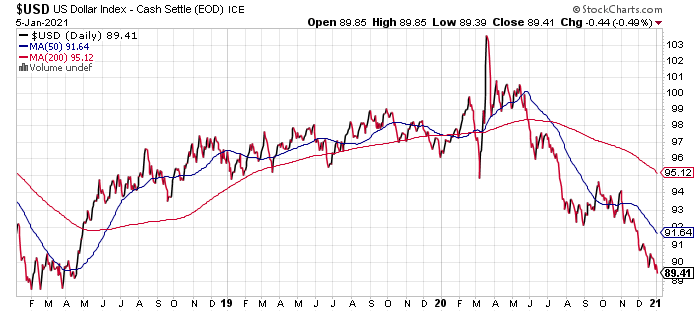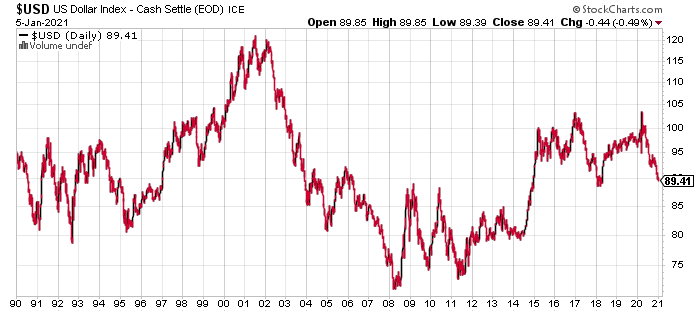The world’s reserve currency has been weakening since May and recent trending behavior suggests the slide has room to run and so it’s time for a short recap of the implications and the outlook for what could be a major driver of investment results in 2021.
Let’s start with the elephant in the room: the downside momentum. The US Dollar Index (USD) slipped to a new 2-1/2 year on Tues., Jan. 5. The 89.4 close (based on daily data) is lowest since April 2018. Using the index’s 50- and 200-day moving averages as an initial guide strongly suggests that a strong downside bias still prevails.

The dollar’s decline in recent months marks a dramatic reversal in a short period, but over the longer run forex volatility tends to be a wash. As a rule of thumb, the expected return for forex risk is zero, at least on a buy-and-hold basis. You can certainly earn outsized returns (or lose lots of money) in currency trading, but in the long run forex risk is, in theory, a wash in terms of generating a risk premium.
The theory tends to align with history through the decades from a dollar perspective vis-a-vis the major currencies on the other side of the ledger. Consider, for example, how USD compares since 1990: Lots of volatility, and several periods of extended trending behavior (up and down), but the current value of the index hasn’t changed much over the past 30 years.

Nonetheless, there are compelling reasons to argue that the greenback will continue to slide in the foreseeable future. As a number of observers have been pointing out recently, the stars appear to be aligning for a continued decline in the buck. Consensus may be a risk factor: collective “wisdom” can be a sign of excess and therefore ripe for reversal. Nonetheless, the greenback’s trend and several macro factors still favor the view that the dollar will continue to weaken. Here’s a quick recap of several points that are animating dollar bears:
- The yield premium on US government bonds relative to foreign bonds has narrowed as the 10-year Treasury rate fell sharply last year. At the end of 2019, the US 10-year yield was roughly 1.9%. Despite rising in recent months, the current 10-year rate is 0.96%, although that’s up from the summer trough of just above 0.5%. Note, however, that comparing rates on a real-yield basis (adjusting for inflation) shows an even tighter spread in some cases. As The Wall Street Journal noted at 2020’s close: “For several years before the pandemic, U.S. interest rates on both the long and short ends of the yield curve were substantially higher than in Europe and Japan—a major source of strength for the U.S. currency. That premium has largely disappeared…”
- Some economists also point to the US trade balance as a factor that will continue to weigh on the buck. Notably, the US current account – a measure of transactions with foreign countries – has turned a darker shade of red recently, driven by the US economy’s relatively strong rebound from the pandemic. In turn, the US appetite for imports has increased faster than demand for its exports. Adding to the deterioration is the slowdown in oil production and exports due to the pandemic. “When you layer deteriorating trends in the non-petroleum trade balance on top of a slowdown in US oil production…that’s just a big problem for the dollar,” says Zachary Squire of Tekmerion Capital Management.
- US monetary policy is expected to stay dovish for an extended period. That’s also true for much of the world. Nonetheless, as long as the Federal Reserve keeps US rates near zero, that’s a key factor favoring a weak dollar. Fed funds futures are currently pricing in a near-certainty that the central bank’s target rate will remain at a 0-0.25% target range through at least Sep. 2021.
- The arrival of Covid-19 vaccine is also a factor, according to some economists. As MoneyWeek reports: “The dollar’s modest pullback is easy to explain, say Eva Szalay and Colby Smith in the Financial Times. ‘A vaccine changes everything.’ Vaccines will hasten a general economic rebound, encouraging investors to move cash out of their US comfort zone and into other world markets. On average, traders predict the dollar will end 2021 down 3% from its current level, but some go much further. Calvin Tse of Citi thinks the currency could slip by 20% next year. Moves on that scale are exceedingly rare in currency markets.”
The investment implications of a weaker dollar: hold more non-dollar assets, such as foreign shares and fixed income. Gold and commodities generally are also thought of as beneficiaries of softer greenback. A growing chorus of cryptocurrency bulls add that the likes of Bitcoin and Ethereum will do well if the world’s reserve currency fades. (For a short list of exchange-traded funds that could benefit from a falling dollar, see this recent review.)
The macro tailwinds appear to be laying the groundwork for softer dollar pricing in the near term, and perhaps longer. This is far from a risk-free trade, but it’s no less extreme to position asset allocation on the assumption that the dollar will remain stable or rise.
In the long run, forex risk will probably remain a wash, but that doesn’t mean 2021 could be increasingly uncomfortable for dollar bulls.
Learn To Use R For Portfolio Analysis
Quantitative Investment Portfolio Analytics In R:
An Introduction To R For Modeling Portfolio Risk and Return
By James Picerno